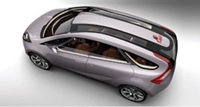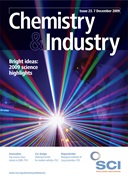Bayer MaterialScience chairman Patrick Thomas talks to Neil Eisberg about the trends that are affecting the automotive sector and the challenges for material suppliers
The automotive industry faces a number of major challenges, ranging from the growth of Asian manufacturing through to environmental pressures to replace conventional gasoline-powered vehicles. China, for example, has now overtaken the US, the spiritual home of the car, in numbers of vehicles produced. Meanwhile, the focus is on alternative renewable fuel sources, such as electricity, to fuel the cars of the future.
Energy and emissions reduction are the biggest global megatrends affecting Bayer MaterialScience (BMS), says chairman Patrick Thomas. ‘The personal desire for mobility doesn’t change; there is still a reluctance to using public transport, whether it is in the US or China.’ China’s cities are bigger, so encouraging a trend towards smaller cars, and Chinese manufacturers are looking directly at electric only cars, without going through the hybrids favoured in the West. There is also a trend towards using less material to make cars, according to Thomas.
Materials and motors
But even though China produced more than 10m vehicles in 2009, it cannot produce enough cars to meet domestic demand and has to import vehicles from India, including the recently introduced Tata Nano. BMS now has its largest manufacturing facilities in China, while many of the vehicles produced there are made by companies that did not exist until very recently.
Even in the US the market is changing, Thomas says, with the industry having to adjust to preferences that are changing faster than would have been imaginable two to three years ago. US manufacturers are now learning that ‘car companies do not decide what the car market wants.’ Consumers are now looking at the use costs of their vehicles, which is the largest part of the overall cost of vehicle ownership, Thomas emphasises. And with longer vehicle life, replacement times have changed. ‘Staying in fashion with a new vehicle is becoming less attractive …Even the “new car smell” is not wanted any more as it is seen as potentially hazardous.’ Consumer pressure for recycling is also encouraging a complete change in component production, he says
The industry response has been to move towards ‘common platforms’, using the same engine, gearbox and even floor pans, and also sharing those platforms with other manufacturers, but then personalising these common components at a mass-produced price.
Following the conversation with Thomas, it was announced that as a result of Italian car manufacturer Fiat’s acquisition of 20% of US manufacturer Chrysler, in future, 50% of Chrysler’s vehicles will make use of Fiat platforms. The loss of scale in sharing common platforms may also have played a part in General Motor’s surprise decision not to sell its Opel operations in Europe, and it is something that was lost when Ford sold its Jaguar/ LandRover business to India’s Tata.
One major result has been smaller volume build cycles. To achieve this, the drive has been to produce simplified components for assembly and disassembly at the end of the vehicle’s life cycle, says Thomas. There are also higher technology expectations, including satellite navigation and incar entertainment. Electronics are therefore now a ‘much larger cost component… and counter-intuitive in terms of simplified design,’ Thomas adds.
To meet these challenges, raw material processing is becoming much more sophisticated. Examples cited by Thomas include the roll-to-roll flat printing of functional films, using conducting inks and organic light emitting diodes (OLEDS) for instrument displays that are then post-formed, replacing the part assembly of groups of components. Such new displays don’t require back-lighting, emitting their own light can incorporate a host of other features, including wiring and touch sensitive switches, by applying up to 19 layers in a cost effective manner. Such displays are already being used in today’s production vehicles, but Thomas notes that there are still lifetime issues with multicolour displays produced this way.
He points out that cars are cheaper than they have ever been, and therefore all material choices are coming under scrutiny, including the use of metals and glass for construction. ‘Glass is highly energy intensive and therefore expensive,’ he says, adding, however, that its durability has been proven over hundreds of years.
There are alternatives to glass, but regulations tend to favour existing technology, Thomas notes. As an example, he quotes the different regulations regarding the use of protective film on car windows, which is allowed in Germany but not in the UK. ‘Research has shown there is more of a hazard from intrusion through glass windows than the inability to escape through a window in the event of an accident. Also intact glass provides more structural strength in roll-over accidents.’ One alternative has been to replace glass with polycarbonate, but poor abrasion resistance has prevented its use for windscreens, although it has been used for glazing applications in other parts of vehicles. A key advantage is that multipart assemblies of glass, rubber and metal can be replaced with a one piece component, like the onepiece sun roof in Smart cars. BMS provides the clear polycarbonate, the opaque ABS/polycarbonate framing and a silicone top coating, and know-how, which can all be processed in the same mould to produce the complete roof component. For moving windows, BMS has developed another approach that involves adding a glass laminate on top of the polycarbonate.
Materials science

Consumers also have an expectation of safety and comfort, says Thomas. But in Germany, for example, ‘the majority of purchases are made without a test drive. There is an expectation that the car will have the appropriate performance.’ As a result, ‘touch and feel’ have become more important, elevating the importance of ‘softtouch’ coatings, for example, says Thomas. ‘The “sensuality of the steering wheel” is a major concern to one German car company’, he adds.
‘There is also less interest in rear seat comfort compared with the front driver and passenger seats’, Thomas continues, adding that the front seats of the latest BMW 3 series have been rated as the most comfortable of any car seat. The seat required the complex polyurethane foam to be produced with varying hardness in one computercontrolled moulding process, giving harder side support with a soft seat cushion.
Coatings are benefiting from Bayer’s nanotechnology developments, according to Thomas, particularly in terms of scratch resistance and self-healing coatings. The addition of nano silicon dioxide to an aliphatic polyurethane top coat can provide resistance to carwash and sand abrasion, but cannot handle ‘keying’ scratches. Self healing ‘memory’ coatings that self heal under IR radiation provide another more expensive solution that lasts for years, and is a response to the desire for longer car life.
As well as electrodes in Li ion batteries for electric cars, Bayer’s carbon nanotubes also have potential applications in metal components. Thomas points out that BMS’ Baytubes can be added to pure aluminium and can increase the metal’s tensile properties to that of steel but at one-third the weight. Using pure aluminium also avoids the potential corrosion problems experienced by complex aluminium alloys.
‘Light metals with nanotubes offer a host of potential applications that can be produced in conventional production equipment,’ says Thomas. ‘Bicycles with aluminium/nanotube bolts are already on the market but it will take time for applications to be adopted in the more sophisticated automotive and even aerospace applications.’
Engine parts are the obvious application, but he believes that even steel structural components could eventually be replaced in high volume vehicles. Such applications are currently in the engine development process, and ‘will be applied commercially within ten years,’ Thomas says. Automotive developers are looking at 30% improvements in weight reduction ‘not single digit improvements’.
‘For car engines then change is possible using aluminium with nanotubes, but for body panels the technology is not yet available to replace steel pressing,’ says Thomas. But such ‘drop-in’ technology is attractive given that recycling just requires remelting. ‘The nanotubes just disappear,’ he adds.
Baytubes have also been used by Hirtenberger PROSAFE Safety Technology in Germany in the manufacture of newly developed spheres designed to prevent the formation of explosive gas mixtures in fuel tanks, particularly in military vehicles. The spheres, to be marketed under the name Safeball, are said to offer advantages over previously used metal mesh plastic foams and can be customised for applications like fire extinguishing.
Dialogue between raw material suppliers and automotive developers is needed at all stages of vehicle development, Thomas emphasises; this is a long-term issue since it takes up to six years before a new car hits the road. ‘Bayer tries to challenge designers to think outside the box. If BMS can provide snap-on panels for Dell laptops, then why not use the same principle on cars,’ he says. There is also potential crossover with the construction sector, he notes, citing the requirement for bombproof glazing in US government buildings and bullet-proof vehicles.
Thomas believes there is a greater willingness outside Europe, and especially in China, to look at different materials. ‘Chinese auto makers don’t work on seven-year design cycles, they commonly work on three-year cycles,’ says Thomas. ‘They ask: “What would you spend seven years doing?”’ He says that Fiat is the first European automotive manufacturer to challenge the process in the same way, recognising that capital equipment investment is a major barrier to change for existing car makers.
Asian producers are manufacturing vehicles to suit their domestic markets, and they are extremely demanding regarding their material requirements, says Thomas. ‘The experience they have gained also means that their export vehicles, that have used European and US designers who understand the market needs, are having an impact on even the most conservative members of the automotive sector: German car manufacturers,’ he adds.
For BMS, bringing this all together involves concept cars. In 2009, these were: the Hyundai I-mode and Velozzi’s Solo cross-over sports utility (SUV) and sports car. The I-mode features BMS’ scratch-resistant coatings, while the group is supplying all the materials used by Velozzi. The Solo has a multifuel microturbine/electric hybrid, with the turbine driving a generator and battery charger, offering over 100mpg. The Velozzi battery-powered sports car is designed to demonstrate that supercar performance can be achieved with an electric vehicle. It features a 770hp AC induction electric motor able to accelerate the vehicle from 0-60mph in only 3 seconds, with a top speed of over 200mph.
As Thomas concludes, it is still possible ‘to have fun with a car without any major environmental impact’.





